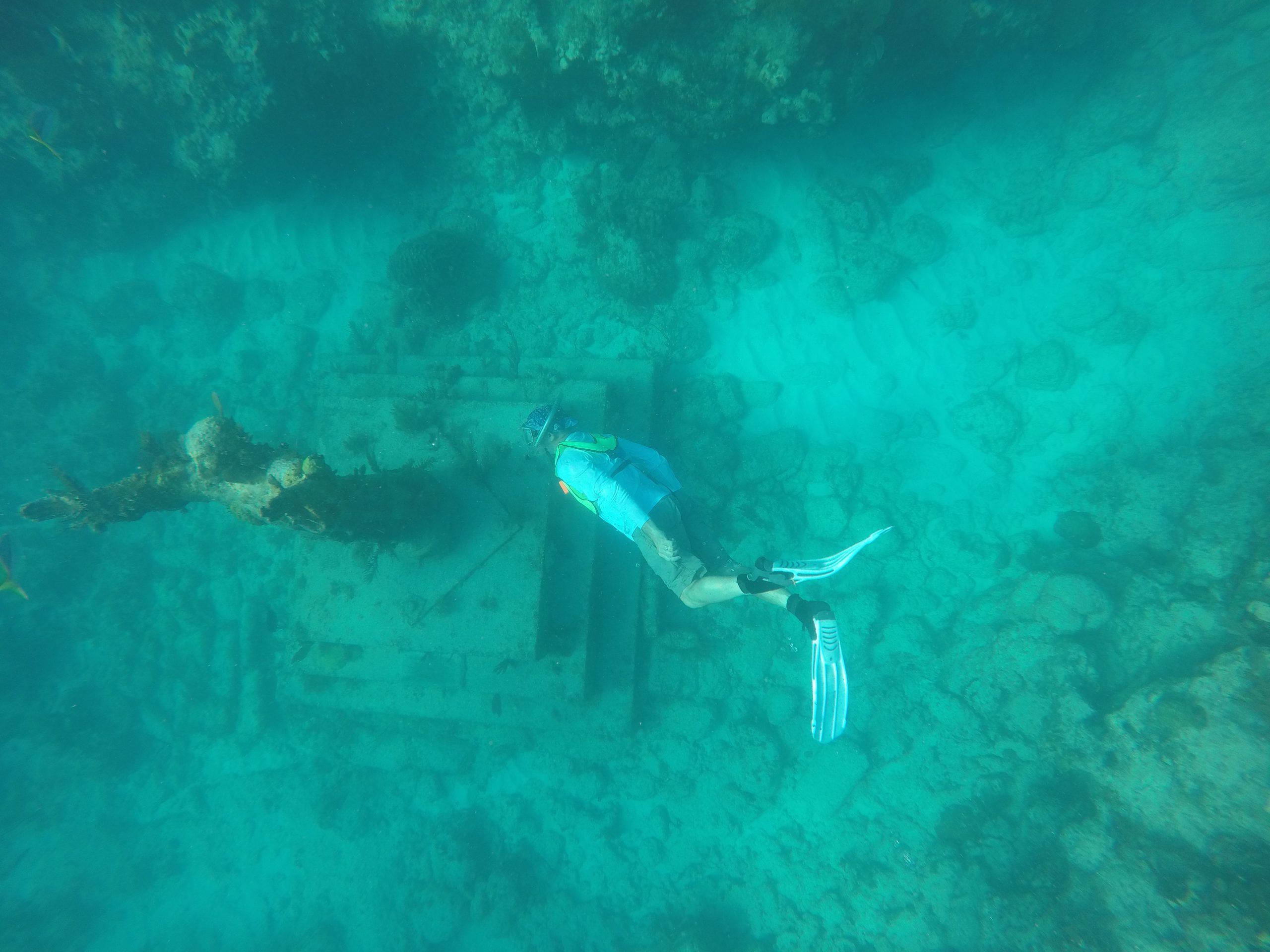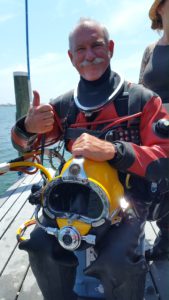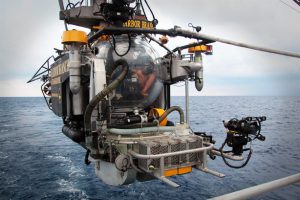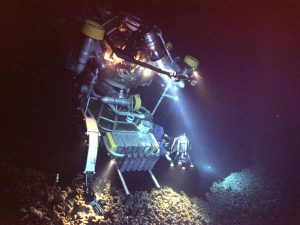In the diving world there are basically three forms of diving: free diving, compressed air diving, and 1-Atmosphere diving. After the recent accident with the OceanGate Titian we thought we would give some basics as to how this form of diving works. Let’s look at all three.
Free Diving
Free diving is just that… free of any diving apparatus. It is just you and the ocean. Frequently called “snorkeling” these days, the diver dons a mask (and at times snorkel), holds their breath and descends as deep and long as they can. Most sport free divers enjoy viewing the bottom in waters less than 10 feet deep. Through practice and training, others can go deeper. Some have dived as deep as 80 feet hunting fish using spearguns and have held their breath well over 2 minutes. There are of course the free diving championships where free divers descend by sleds to extreme depths under extreme pressure and ascend by air lift bags. This form of diving has not been of great use in science because the diver cannot go very deep and cannot stay very long. This makes behavior observations and data collecting difficult. Though it has been useful for shallow water surveys to do more “science” under the sea a different form of diving would be needed. One where you can go deeper and stay longer.

Photo: Molly O’Connor
Compressed Air Diving
Very early in science history they saw the need to develop some form of diving that would allow scientists to reach greater depths for longer periods of time. This meant taking the air with you. Dive bells made from crude materials were developed and tried as early as the 18th century. But most were very unreliable due to the materials used.
The concept of compressed air diving is that of using an air compressor to compress atmospheric air into a hose down to the diver. The diver would be able to regulate the air flow using a “regulator”. This concept was first used in what we now call hardhat diving. Divers wore heavy canvas suits with weighted boots and weight belts to reach the bottom. Air would be compressed using an air compressor on deck and fed to the diver using a tethered hose. The air would reach the diver within a brass helmet that had small view ports and a regulator on the back to regulate the air flow. Special care had to be taken to avoid getting exhaust from the air compressor into the air mix going to the diver, which could be toxic. There was also the threat of the air compressor running out of fuel and stopping the flow to the diver, who in their weighted apparatus could not reach the surface by swimming.
Another part of the problem was the pressure under which the diver is exposed. Standing on the surface of the earth you are under pressure. The atmosphere above is being pulled to the surface by the earth’s gravity and all objects are in its way. There is pressure from the air around you squeezing on your body at about 14.7 pounds for every square inch of your body (pounds per square inch – p.s.i.). We call this 1-Atmospheric pressure (14.7 p.s.i.). You do not feel this pressure because your body adjusts to it. However, when climbing a mountain, or flying a plane, there is less air above you and the atmospheric pressure decreases. We feel this in our ears (which helps adjust for pressure change) and feel the “equalization” of this pressure when we lightly blow our nose, or yawn – our ears “pop” and we do not feel the pressure any longer.
Water weighs more than air. As you descend into the ocean you feel the atmospheric pressure above the ocean surface AND the water pressure above you as well. The deeper you go, the greater the pressure. The rate of change is 14.7 psi every 33 feet (10 meters). At the surface we say we are at 1-Atmosphere (14 psi – 1-ATM). At 33 feet below the sea, you are at 2-ATMs (29.4 psi). At 66 feet you are at 3-ATMs (44.1 psi) and so on. Compressed air divers are exposed to this pressure as they descend and must equalize by “clearing” (lightly blow your nose while pinching it or yawning). Due to their sinus situation, some divers can clear more often than others and dive deeper. You do not dive with a head cold or other sinus problems, because you will not be able to clear. Even with good sinuses, there is a limit the human body can take. Most sport divers today dive to around 100 feet (4 ATMs – 58.8 psi). Some can/do dive to 200 feet (7 ATMs – 103 psi), but to dive deeper requires technical training and equipment. Technical divers need to be in good physical shape. Some professional technical divers have reached depths of 400 feet (13 ATMs – 191 psi). Below this is very hard on the human body. This is about the limit for compressed air diving.
But as Jacques Cousteau stated… “the problem is not so much going down… it’s coming back”.
What the famous ocean explorer meant by this was that the pressure on the diver not only squeezed your sinuses, but it also squeezed all of the gases in your tissues. The air you are breathing is about 78% nitrogen, 21% oxygen, and 1% trace gases. As you descend these gases are squeezed into your tissues and circulatory system. If you return too fast, these gases will expand in your tissues and cause what is called “the bends” (due to the fact your limbs begin to bend when it happens). It can be lethal and must be avoided. The deeper you go and the longer you stay, the more gas you squeeze into your system and the slower you must go to return to the surface to allow these gases to escape your system. Years ago, the U.S. Navy developed dive tables that told the diver how much time they had at a certain depth to safely return to the surface without stopping (non-decompression dives). Even though you could safely return without stopping, you were taught not to pass your bubbles as you ascended to make sure you were not coming up too fast. For example, a dive to 80 feet allowed you 30 minutes bottom time. You would descend, clearing your ears to adjust for the pressure change, make your dive watching time on your dive watch, and slowly ascend not passing your bubbles at, or before, the 30-minute time limit. Even once you were back on the surface there were still dissolved gases in your system and the table would let you know how long you had to sit to completely clear your system. Today, dive computers are used by divers to track this. They have alarms on them to let them know when it is time to ascend, and all divers now make a safety stop at 15 feet for five minutes JUST to make sure. Those who remain at 80 feet for longer than 30 minutes are considered “decompression divers” and the dive tables (dive computers) let you know at what depth you must stop (and for how long) to allow the dissolved gases to escape your system and safely return to the surface.
But the Bends were only one issue. Excessive amounts of nitrogen squeezed into your system could cause nitrogen narcosis during the dive. This gives the diver a “drunk” feeling, you begin to see things that are not there, your view of the sea bottom is inverted or flipped where the bottom is up and the water down. Just as driving drunk, this can be very dangerous. The diver is no longer alert and can make some fatal mistakes. And then there are embolisms. When you ascend the gases expand, if you are holding your breath the gases in your lungs will expand and may rupture the alveoli in your lungs. This is an embolism.
With hardhat diving you are tethered to the ship, you could only explore as far as your tether would allow you. In the 20th century they developed the Self-Contained Underwater Breathing Apparatus – SCUBA. A cylinder, originally made of steel and now aluminum, was filled with atmospheric air using an air compressor. This cylinder was strapped to the divers back and rigged with a two staged regulator that you could place in your mouth. The air was provided on demand by the diver. Today SCUBA diving is enjoyed by sportsman, adventurers, and scientists the world over. But the lessons mentioned above must be learned. No one should try SCUBA without attending a SCUBA certification course to learn how to do so safely.

Photo: Robert Turpin.

Photo: NOAA
1-Atmosphere Diving
There is still a depth and time limit with compressed-air diving. Safe SCUBA is usually less than 200 feet, and you can explore as long as your air supply within the tank will allow you. Hardhat diving can supply more air, and increase time on the bottom, but there is still a depth limit and, as explained above, the longer you stay the more problems can occur for the diver. Those problems for the diver are due to the body being exposed to pressure (5-6 ATMs = 74-88 psi). IF the diver could remain at 1 ATM throughout the entire dive, then the Bends, Narcosis, and Embolisms would not be a concern. But how do you build a vessel where the inside pressure is 14.7 psi, and the outside is 100 psi? Could you build one that would keep the ocean from imploding it? And 100 psi is where compressed air divers can reach now. Could we build one that could reach 1000 feet (31 ATMs = 445 psi), or 10,000 feet (304 ATMs = 4454 psi). Imagine that… a vessel where the inside pressure is 14.7 psi and the outside environment is pushing in at 4454 psi!, could this be done?
Because we wanted to explore the deep sea, engineers began designing vessels for such a dive almost a century ago. Through design and testing, they learned quickly that a sphere was the best shape to use. With no corners, there are spaces for the external pressure to “grab” and either push or pull. You would want to use the strongest material available, and at that time it was steel. So, a steel sphere might do the trick. There was the issue of a window, or view port. If you had a steel sphere that could hold up to great pressure, could you put a window in it? If not, what is the point of going? Science developed an acrylic plastic (Plexiglas) that would bend some. Engineers discovered that cutting this acrylic glass window into a shape of a cone would absorb more pressure and allow the vessel to descend deeper allowing the 1-ATM divers to see outside. One window had an internal light that could illuminate the ocean outside so they could see.
Testing of such a vessel began in the early 20th century. The first dives came with a vessel called the bathysphere. This was designed by engineer Otis Barton and operated by himself and marine scientist Dr. William Beebe. The sphere was about five feet in diameter, 1 inch steel walls, and two viewing ports filled with crushed quartz glass (no acrylic glass yet). It would be lowered by a cable that also included a phone line for communication. Air was provided by cylinders within the vessel and there were absorbent materials to collect the expelled CO2. Air was moved around via a fan. The vessel was tested many times at varying depths before they allowed divers on board. The first dives were to depths of about 500 feet (16 ATMs = 223 psi), but they eventually reached a depth of 3000 feet (91 ATMs = 1336 psi). There were several issues during the course of these dives. Early on, the cables would become twisted, and they had to develop a method to keep this from happening. On one dive, water began leaking in after only going a few feet down. Once back on deck it was discovered one of the brass bolts that held the hatch shut was not tightened properly (showing the importance of COMPLETE review of the vessel before descending). The most catastrophic incident came during a test dive. There were initially three viewing ports on the bathysphere, and one had been covered with a steel plug. Dr. Beebe wanted to switch out the steel plug for another crushed quartz glass window so that he could do a video of a dive. They did, and during the test dive (to several hundred feet with no humans onboard) the new quartz window filled with water upon return. Dr. Beebe himself decided to unbolt the door. The intense pressure of water (due to the leak at depth) shot the brass bolt across the deck of the support ship like a bullet, then came the explosion of water that shot all the way across the deck to the crane that lowered the bathysphere. Reaffirming the dangers to this form of diving and the need for safety and detailed inspection of all equipment. Unmanned testing was a must for any new innovation tried on the system.
Using this sphere design the Trieste was designed by Swiss engineer Auguste Piccard. The goal of this vessel was to reach the very bottom of the ocean – the Challenger Deep at the bottom of the Marianna’s Trench – 36,000 feet = 1090 ATMs = 16,036 psi. This 1-ATM vessel would have an internal pressure of 15 psi and an external pressure of 16,000 psi. Obviously great care, thought, designing, and testing had to be done to pull this off. The sphere was steel, five inches thick, and had a diameter of seven feet. Unlike the bathysphere Dr. Beebe dove in, the Trieste was unthethered, so called a bathyscaphe. It operated like a hot air balloon. A large hull was attached above the sphere filled with gasoline (less dense than seawater and would float like hot air balloon). To sink, portions of the vessel would fill with seawater and there were conical cylinders filled with iron pellets (which would be released so the vessel would float back to the surface, just as bags of sand are dropped to allow the hot air balloon to rise). The view ports did use acrylic glass.
The dive took place in 1960. It took about four hours to reach the bottom. At 30,000 feet one of the exterior acrylic glass windows did crack but it did not impact the sphere nor the crew and the dive continued. They were on the bottom for about 20 minutes and were able to observe living organisms at the deepest part of our ocean. The pellets were dropped, and the ascent took about three hours. It was a marvel of engineering.
In the latter half of the 20th century the material for the spheres switched from steel to titanium. Electric motors were added so the pilot could literally drive around on the ocean floor. After speaking with a submersible pilot, he told me it was like driving a golf cart. An array of sampling equipment (buckets, vacuums, mechanical claws, etc.) were added to these vessels in order to collect from the seafloor. Many are outfitted with video cameras, and many have cameras that automatically photograph every so many minutes. The business of 1-ATM diving has vastly improved. One new design owned by the Harbor Branch Oceanographic Institute in Florida has a sphere made of the acrylic glass material. It is five inches thick, and your view is almost 360o. However, due to the material of the sphere being less than titanium, it has been certified to depths of no more than 3000 feet (92 ATMs = 1336 psi).
One of the more famous deep-sea submersibles is Alvin. Built in the 1960s, it has made more than 4000 dives to the deepest parts of the ocean, including the Titanic. It has been certified to depths up to 21,000 feet (637 ATMs = 9354 psi). It has discovered deep-sea hydrothermal vents, viewed deep ocean rift valleys, as well as videoed numerous deep-sea creatures. It has truly expanded marine science.

Photo: NOAA

Photo: NOAA
When the recent accident involving the submersible Titan occurred, I was camping out west in an area with no service. I did not hear about it until it was basically over. I did not get a lot of questions about I from the public but was interested in what went wrong. I did some reading and found the following.
Titan was owned and operated by a company called OceanGate based in the state of Washington.
OceanGate developed two submersibles – Cyclops 1 and Cyclops 2. Cyclops 2’s name was changed to Titan.
The vessel had a pressure hull made of titanium but was using reinforcement bars made from carbon fiber instead of steel.
The company stated that the pressure hull had been tested by the Applied Physics Lab at the University of Washington. It was approved for 4285 psi. That is 3000 meters, 9800 feet, 298 ATMs.
The Titanic sits at 12,500 feet, 3676 meters, 380 ATMs, 5568 psi.
It made several dives to the Titanic in 2021 and 2022. No incidents. A reporter who made one of those dives stated that they had to sign a waiver that stated they understood it was an experimental vessel.
The CEO was quoted several times stating “safety impedes innovation”.
There were emails from engineers prior to the first dive to Titanic that it was not safe to do so in this vessel. One billionaire from the west coast was offered a trip down but declined because of the safety issue.
Looking over the remains of Titan that reached the surface, one engineer stated that the implosion may have been due to the use of carbon fibers, or, an issue with one of the viewing ports. They were not sure. More reivew was needed.
As with so many airplane, shuttle, and ship accidents, the debris from the wreck will be examined more thoroughly and we will have a report of the most probable cause of the implosion.
It was a horrible accident, and we feel for the families of those lost during this dive. The statement about safety certainly catches our attention. This was a dive to 12,500 feet. Safety should have been a priority. The same can be said for any machine we use. I drive a camper van out west, several thousands of miles. We did, and should, make sure the vehicle was prepared for this. I have a safety check list for our camper before we pull it for miles. We should do the same for our cars. Many of you jump in your boats and head miles out into the Gulf of Mexico for a day of fishing. Do not neglect a safety check of your vessel before leaving. We know SCUBA divers check their gear before they dive, we know that airlines check their planes, we know the US Navy will not let a Blue Angel leave the ground unless it has passed a safety check. I have had friends who have dived on the Johnson Sea Links and Alvin. They have told me the crew goes over the vessel several times the night before a dive to make sure all is good, and the ship is ready. As a dive buddy of mine who served as a US Navy SEAL told me once – “Take care of your equipment… and your equipment will take care of you.” This is good advice for everyone.
Reference
Wikipedia
Source: UF/IFAS Pest Alert
Note: All images and contents are the property of UF/IFAS.



